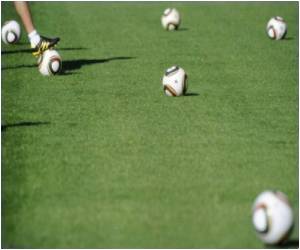A show of supreme fitness by the best footballers will be presented at the World Cup in Brazil, but danger will threaten at every match

The race by Colombia's star striker Radamel Falcao to be ready for the tournament highlights the stakes.
Falcao suffered ruptured cruciate ligaments playing for Monaco in a French League Cup game in January. But after state of the art keyhole injury hopes to play for his country at the tournament -- and risk a new injury.
"We know from top teams there's always like 20-30 percent of players injured. This is a big problem," said Ewald Hennig, professor of biomechanics at Duisburg-Essen University in Germany.
Combining high speed, body rotation and impact, football has one of the highest injury rates of any sport.
The hidden drivers for the many injuries include long seasons, public demand for spectacle and even innovations in kit and training.
Advertisement
"Professional football also has a dark side, and that is the sustainable health of its players in the long term," according to Vincent Gouttebarge, former professional footballer and chief medical officer of the FIFPro union that represents over 65,000 professional players worldwide.
Advertisement
While quickening the pace of the game, "it is much more dangerous, the training that they do these days," said Hennig.
He pointed to a shift in muscle conditioning training that has spread among many trainers.
Previously, players were told to run uphill and walk down -- but this has shifted to sprinting downhill or down steps.
The technique, adopted from track and field athletes, aims at training the nervous system to react quicker and boosts muscle coordination. But more force is exerted on joints and bones, elevating the risk of injury, said Hennig.
Boot design is also controversial.
In football's early days, boots were higher to protect the ankle and sturdier to absorb the impact from an opponent's studs and other shocks. Today's soccer shoe weighs about 100 grammes (3.5 ounces), compared to as much as a kilogramme.
The new boots also have more traction, so there are higher forces when players change direction: a torsion that leads to more muscle stress and injuries, said Hennig.
Fatigue -- physical and mental -- are other factors.
With some European tournaments wrapping up just three weeks before the World Cup starts on June 12, leaving little time for players to recover.
"We consider in France that approximately one month of rest is needed between the end of a championship and the World Cup," said Jean-Francois Toussaint, director of France's IRMES sports medical institute.
"But the duration of recovery varies from player to player, and if we do not take that into account, there is a risk of a rise in injuries."
- Hi-tech help -
Though it cannot eliminate injury, science can help top athletes prepare better and recover sooner.
One tool has helped coaches to pinpoint risk times for injury, enabling them to adjust tactics or substitute stars to keep them safe for the next match.
Predictably, the risk times are the last quarter-hour or so of a match, when tiredness can lead to dangerously mis-timed tackles.
Other injury hotspots are after a team has scored or picked up a yellow or red card, or when it is in the lead, according to Sweden's Sahlgrenska Academy, which look at data for the last three World Cups.
Cryotherapy, involving immersion in an ice bath or liquid nitrogen chamber after a match, is said to quell inflammation and boost blood circulation and muscle regeneration.
Specialists have developed training programmes that increase oxygen intake and build resistance to injuries by stabilising joints and improving balance.
Equipment helps too, with lighter, stronger guards and braces, and nutrition for high energy and strength has improved vastly.
Another area is mental health, where there is a growing recognition of the pressure players are under to succeed.
A FIFPro study last month reported that nearly 40 percent of retired pros experience symptoms of anxiety or depression, mainly as a result of physical problems from injury.
"There is definitely a trend in international top football now to employ more and more psychologists," said Geir Jordet, director of psychology at the Norwegian premier league's centre of football excellence.
In the end, there will always be risk however.
"The public wants to have exciting games, fast games, they want to have aggressive play. And soccer players, they want to win," said Hennig.
Source-AFP









